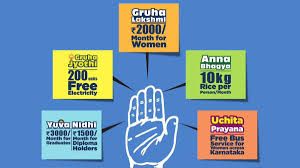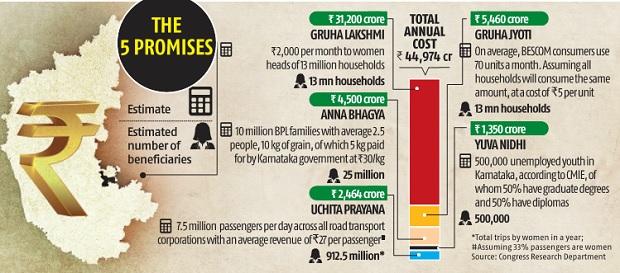The Karnataka Guarantee Schemes: its implementation and effects
Discussing the impact the 5 Guarantees Scheme has had on Karnataka- economically and socially.
11 Jul '25
3 min read

Few months before the 2023 State Legislative elections in Karnataka, the INC announced a list of 5 guarantees:
- Rs 2,000 monthly assistance to women heads of all families (Gruhalakshmi)
- 200 units of power for free to all households (Gruhajyoti)
- Rs 3,000 every month for graduate youth and Rs 1,500 for diploma holders (Yuvanidhi)
- 10 kg rice per person per month (Annabhagya)
- Free travel for women in the State public transport buses (Shakti)

Immediately, several people were excited. Various people expressed mixed views. While some felt it would be useful for a lot of people, others were of the view that it could hamper Karnataka’s economy badly. In the hot and sultry month of May 2023, the elections were held. Results were announced soon after, and INC appeared as the single party with the most votes, comfortably gaining a majority.
During their campaigning, few were of the opinion that INC rode on these initiatives, or “freebies” as some might call them, for their votes. Without discussing this, all 5 guarantee schemes were successfully implemented in Karnataka by the end of the year. The guarantees have had both positive and negative impacts on Karnataka’s economy. Let us discuss them here.
Firstly, the guarantees have emerged as a lifesaver to the poor. It has made basic needs such as electricity, transport, and food accessible to millions as part of this. It has boosted the local economy through the increased number of subsidies, encouraging small businesses and consumer spending. The guarantee schemes have empowered women and youth with direct benefits. It has helped address youth unemployment by giving them allowances under Yuvanidhi. Gruhalakshmi has helped housewives become independent and not rely only on their husbands for money. Gruhajyoti has helped the poorest of the poor attain the benefit of electricity. Annabhagya reiterates the provision for each person to get sufficient food to consume while Shakti scheme helps women travel from one place to another in ordinary buses for free.
But, the story is gloomier on the economic front. A significant part of Karnataka’s budget gets used up in this. This year, approximately Rs. 51,000 crores have been allocated towards the guarantee schemes, 17% of the total revenue receipts. This strains the state budget and restricts more expenditure on development and other necessities. To make up for this money, the government has increased taxes on fuels and property, burdening the middle-class households further. Some people might feel fulfilled with the cash they receive and might not work further, discouraging active participation and skill-building for them. Since this is a purely state endeavor without federal aid, questions arise on if such large-scale spending can be maintained. 
In essence, I would like to conclude by saying that the Guarantees Scheme, though very helpful for a narrow band of people, makes the lives of the middle class much tougher due to the excessive taxes on them to compensate for the money lost every year. Thus, if the present method of implementation of the scheme is modified slightly to help only those in need, and not everyone in general, this scheme can become revolutionary in encouraging equality in India.
~Rachan R. Rai
Grade: 10
Category:Personal Opinion
Written by RACHAN R RAI
A humble student with a keen interest in writing.
0 Followers
0 Following
